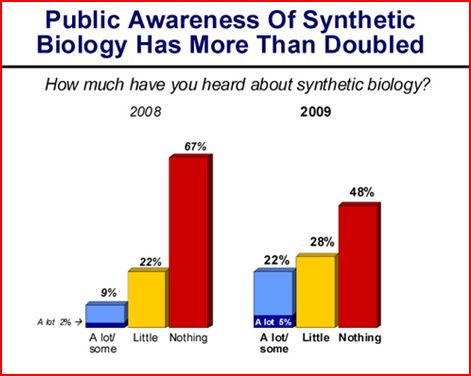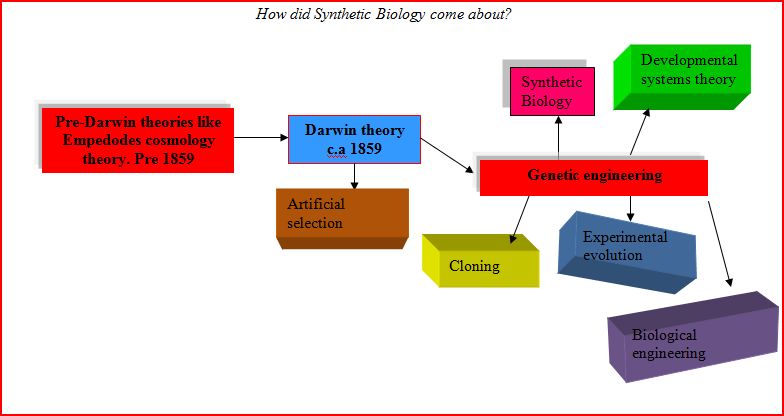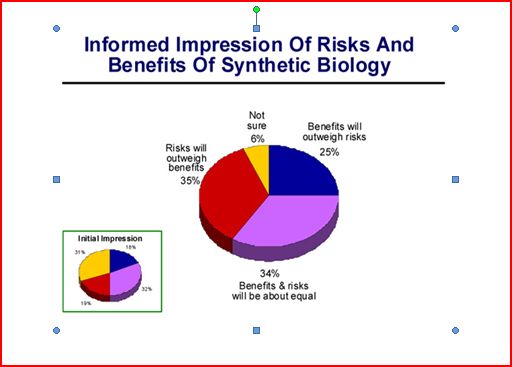Team:UCL London/Ethics
From 2009.igem.org
| (4 intermediate revisions not shown) | |||
| Line 6: | Line 6: | ||
==== Welcome to the Ethical world of Synthetic Biology with the Stress Busters at UCL! ==== | ==== Welcome to the Ethical world of Synthetic Biology with the Stress Busters at UCL! ==== | ||
| + | |||
| + | |||
| Line 11: | Line 13: | ||
| - | Below is a bar chart taken from www.scienceprogress.org | + | Below is a bar chart taken from www.scienceprogress.org. This statistical data displays that even though there is an increase in the amount of people who have heard about synthetic biology, there is still a vast amount of people in our societies and communities who do not. |
[[Image:Pic1.JPG]] | [[Image:Pic1.JPG]] | ||
| Line 31: | Line 33: | ||
| - | This diagram was taken from www.scienceprogress.org | + | This diagram was taken from www.scienceprogress.org |
| - | + | ||
| - | A survey was conducted (with the general public) on the “Informed impression of Risks and benefits of Synthetic Biology in our society”. | + | A survey was conducted (with the general public) on the “Informed impression of Risks and benefits of Synthetic Biology in our society”. The source shows that just over 50% of the people being surveyed believed, that the benefits of synthetic biology either: outweighed the risks or was about equal to the risks which could occur. |
| - | Synthetically created/modified organisms can have accidental side effects. Some scientists claim that synthetic organisms could assist to solve environmental problems like contamination of soil. This also implies that potentially harmful synthetic organisms should be released into the contaminated soil. | + | Synthetically created/modified organisms can have accidental side effects. Some scientists claim that synthetic organisms could assist to solve environmental problems like contamination of soil. This also implies that potentially harmful synthetic organisms should be released into the contaminated soil. E.g. a "Traffic Light Stress Sensor", could be modified to monitor specific harmful chemicals in the soil. |
| - | In addition to bioterrorism, synthetic biology leads to | + | In addition to bioterrorism, synthetic biology also leads to so called bio-error threats, because the manufactured microorganisms could "escape" into the natural environment. At present scientists do not yet fully understand how to synthesize organisms with conventional replication and mutation properties, not only is the individual behaviour of an escaped organism difficult to foreknow and detect, its effect on the natural world is also equally impossible to foretell. |
| - | + | In addition there is also a risk of natural genome pool contamination. It is possible that synthetic organisms could transfer genes to natural organisms. | |
| - | Intellectual property is a number of distinct types of legal monopolies over specific creations of the mind, both artistic and commercial, to the corresponding field of law. Under the intellectual property law, owners are granted certain exclusive rights to a range iof intangible assets, such as musical, literary, and artistic works; ideas, discoveries and inventions; and words, phrases, symbols, and designs. Various companies and organizations are able to gain these rights over any new discoveries/inventions. A draw back about this is that poor countries cannot copy the developed technology to create drugs for example, themselves because of intellectual property rights (IPR). Examples of intellectual property right issues can be seen in the discussion about generic drugs for example for the treatment of HIV/AIDS. The IPR system makes it very difficult for developing countries to import generic (cheaper) medicines. | + | Intellectual property is a number of distinct types of legal monopolies over specific creations of the mind, both artistic and commercial, and relating to the corresponding field of law. Under the intellectual property law, owners are granted certain exclusive rights to a range iof intangible assets, such as musical, literary, and artistic works; ideas, discoveries and inventions; and words, phrases, symbols, and designs. Various companies and organizations are able to gain these rights over any new discoveries/inventions. A draw back about this is that poor countries cannot copy the developed technology to create drugs for example, themselves because of intellectual property rights (IPR). Examples of intellectual property right issues can be seen in the discussion about generic drugs for example for the treatment of HIV/AIDS. The IPR system makes it very difficult for developing countries to import generic (cheaper) medicines. |
| - | In the World Trade Organization Doha agreement it states developing countries are allowed to import generic medicine: “if they can provide evidence of the public health concern, display the inability of the domestic pharmaceutical industry to produce the drug itself, and prove that it will only use the drug for public, non-commercial purposes | + | In the World Trade Organization Doha agreement it states that developing countries are allowed to import generic medicine: “if they can provide evidence of the public health concern, display the inability of the domestic pharmaceutical industry to produce the drug itself, and prove that it will only use the drug for public, non-commercial purposes." Intellectual property rights gained by companies and organizations protecting their inventions in synthetic biology can deter developing countries; and increase their dependence on rich countries and companies. |
| - | The current trend of overly broad patents, layering both the basic building blocks of biological life and synthetic systems responsible for creating life, run the risk of creating monopolies in the industry. Such companies and countries create “patent thickets”; a weighty mesh of overlapping intellectual property rights that a company must hack its way through | + | The current trend of overly broad patents, layering both the basic building blocks of biological life and synthetic systems responsible for creating life, run the risk of creating monopolies in the industry. Such companies and countries create “patent thickets”; creating a weighty mesh of overlapping intellectual property rights that a company must hack its way through, to actually commercialize new technology. |
[[Image:Pic4.JPG|700px|]] | [[Image:Pic4.JPG|700px|]] | ||
Latest revision as of 03:20, 22 October 2009
Welcome to the Ethical world of Synthetic Biology with the Stress Busters at UCL!
The conscious exploitation of selective power has become common in experimental biology and has lead to novel areas in Science and Technology. Synthetic Biology is defined by the design and fabrication of biological parts/systems that both do and do not already exist in the world we live in today. Many scientists such as: Stanely Cohen and Herbert Boyer (in 1973 who invented the technique of DNA cloning), and Waclaw Szybalski who introduced the term “synthetic biology” have been criticised on their work in relation to ethics. Our UCL_London team endeavours to define and explain any ethical points in relation to Synthetic Biology and the "Stress Lighter".
Below is a bar chart taken from www.scienceprogress.org. This statistical data displays that even though there is an increase in the amount of people who have heard about synthetic biology, there is still a vast amount of people in our societies and communities who do not.
Our UCL_London iGEM team went the extra mile to conduct interviews with staff and students across disciplines at UCL; to find out how well spread the concept of synthetic biology is and also what it is being associated with. We intend to raise awareness at UCL, about synthetic biology and iGEM. Moreover a survey is being conducted currently at UCL which includes interviewing students and staff; as well as a questionnaire which is available at the following link:
http://FreeOnlineSurveys.com/rendersurvey.asp?sid=nnrzscgojwnwv76650008
Bio-security and Bio-safety are two fundamental topics related to the area of ethics in Synthetic Biology. Bio-security is defined as a set of preventive measures designed and created to reduce the risk of intentional removal/destruction of a delicate biological material. Bio-security is profoundly related to the progress of synthetic biology. The fundamental issue/dilemma we face is that we do not want to slow down research and beneficial technological developments; or at the same time enhance the gateway to harmful products/bioterrorism. Moreover, the debate is also whether to restrict some of this information on standardised parts or key reactants.
Synthetic Biology is being used as a tool in the expansion of science today. A major issue about synthetic biology is the ease in which data can be misused (due to the openness of information from various sources). This can lead to the production of known, modified or new micro-organisms. These micro-organisms can be designed to be deadly to humans either directly or indirectly. Researchers all over the world have portrayed that it is possible to create or rebuild deadly viruses. The production of biological material and chemicals/reagents such as oligonucleotides are becoming less expensive as is the purchase of wet-lab equipment. "The Traffic light sensor", was created solely to detect specific stresses that the cells are under. The device is not harmful and does not pose any threats to the 'Stress Busters' or the public.
Moreover, an European Union high level expert group, came to the conclusion that there are no qualitatively safety implications of synthetic biology, aside from the far greater capacity for manipulation and control that it will afford (EU Commission 2005).
This diagram was taken from www.scienceprogress.org
A survey was conducted (with the general public) on the “Informed impression of Risks and benefits of Synthetic Biology in our society”. The source shows that just over 50% of the people being surveyed believed, that the benefits of synthetic biology either: outweighed the risks or was about equal to the risks which could occur.
Synthetically created/modified organisms can have accidental side effects. Some scientists claim that synthetic organisms could assist to solve environmental problems like contamination of soil. This also implies that potentially harmful synthetic organisms should be released into the contaminated soil. E.g. a "Traffic Light Stress Sensor", could be modified to monitor specific harmful chemicals in the soil.
In addition to bioterrorism, synthetic biology also leads to so called bio-error threats, because the manufactured microorganisms could "escape" into the natural environment. At present scientists do not yet fully understand how to synthesize organisms with conventional replication and mutation properties, not only is the individual behaviour of an escaped organism difficult to foreknow and detect, its effect on the natural world is also equally impossible to foretell.
In addition there is also a risk of natural genome pool contamination. It is possible that synthetic organisms could transfer genes to natural organisms.
Intellectual property is a number of distinct types of legal monopolies over specific creations of the mind, both artistic and commercial, and relating to the corresponding field of law. Under the intellectual property law, owners are granted certain exclusive rights to a range iof intangible assets, such as musical, literary, and artistic works; ideas, discoveries and inventions; and words, phrases, symbols, and designs. Various companies and organizations are able to gain these rights over any new discoveries/inventions. A draw back about this is that poor countries cannot copy the developed technology to create drugs for example, themselves because of intellectual property rights (IPR). Examples of intellectual property right issues can be seen in the discussion about generic drugs for example for the treatment of HIV/AIDS. The IPR system makes it very difficult for developing countries to import generic (cheaper) medicines.
In the World Trade Organization Doha agreement it states that developing countries are allowed to import generic medicine: “if they can provide evidence of the public health concern, display the inability of the domestic pharmaceutical industry to produce the drug itself, and prove that it will only use the drug for public, non-commercial purposes." Intellectual property rights gained by companies and organizations protecting their inventions in synthetic biology can deter developing countries; and increase their dependence on rich countries and companies.
The current trend of overly broad patents, layering both the basic building blocks of biological life and synthetic systems responsible for creating life, run the risk of creating monopolies in the industry. Such companies and countries create “patent thickets”; creating a weighty mesh of overlapping intellectual property rights that a company must hack its way through, to actually commercialize new technology.
 "
"



